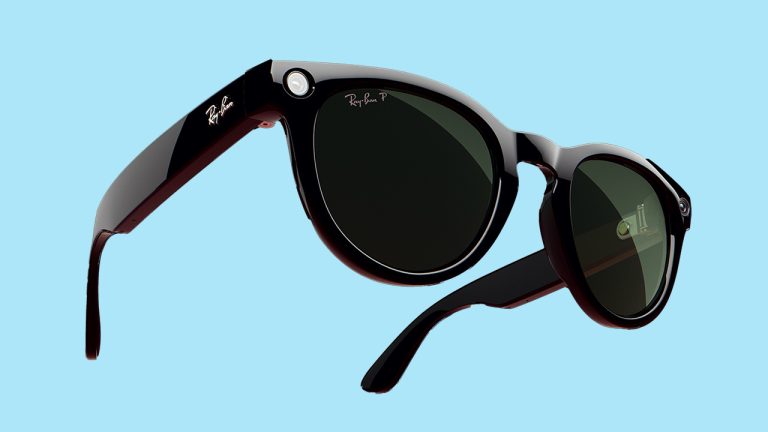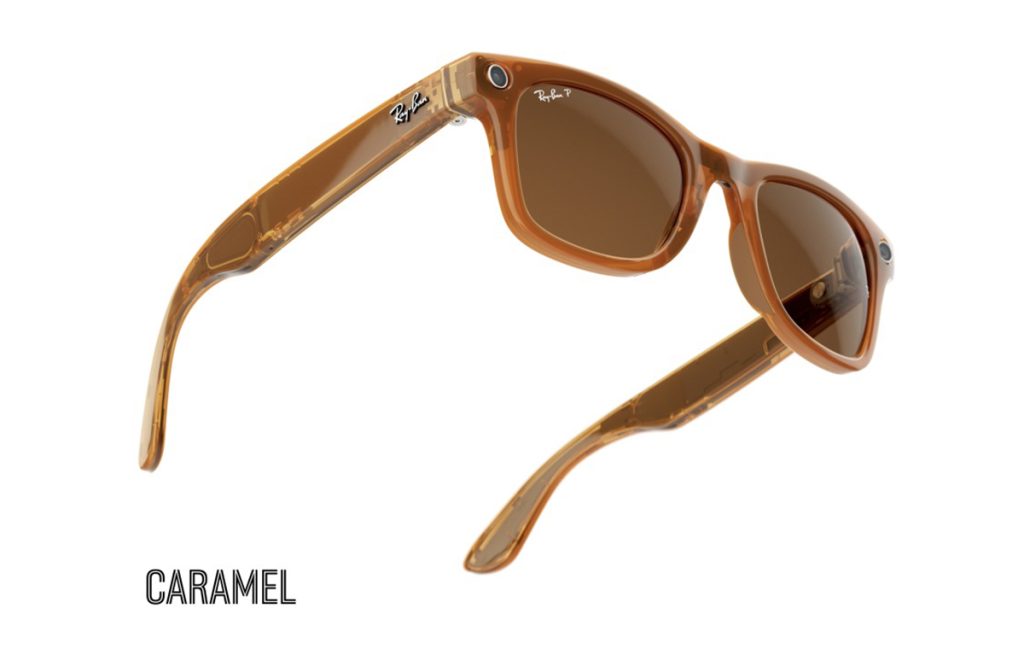Introducing a new era of smart glasses in collaboration with a renowned sunglasses manufacturer is precisely the innovative move one would expect from Meta, especially as the northern hemisphere approaches winter. Despite the less-than-sunny conditions in the UK, I’m currently putting the new Ray-Ban Meta Smart Glasses to the test.
In this distinctly non-sunglasses season of early November, donning a pair feels, in the most British of terms, a bit like a “pillock” (a bit foolish). However, these Ray-Bans go beyond the conventional role of blocking sunlight, although they excel at that too, meeting international safety standards for the US, UK, EU, and Australia. Available not just as sunglasses, Ray-Ban offers two frame styles—the classic Wayfarer and the new Headliner—in various colors with lenses ranging from clear to transitions to dark shades. Prescription lenses, likely a necessity, come at an additional cost.
Regardless of the chosen combination, the focus of the Ray-Ban Meta Smart Glasses lies in the tech embedded within the frames. Packed with cameras, speakers, and communication tools, these glasses aim to empower wearers to effortlessly capture and share their experiences.
Building on the foundation of 2021’s Ray-Ban Stories, the new model boasts significant hardware upgrades, prompting Meta to confidently brandish its name. The integrated camera takes center stage with a notable jump from 5 MP to 12 MP, resulting in higher photo resolution. Video capabilities also see improvement, although remaining at 30 fps.
On the audio front, the frames feature five discreetly placed microphones for enhanced video audio quality. Complementing this, directional speakers positioned just in front of the ears promise a 50 percent volume increase and twice the bass compared to their predecessors.
Enhanced communication features include support for Wi-Fi 6 and Bluetooth 5.3 standards. Notably, onboard storage receives a substantial 8X upgrade, soaring from 4 GB to 32 GB. With these across-the-board improvements, the question remains—how do they fare in practical use?
Smoothly Stylish

Wearing these smart glasses is a delightful surprise in the comfort department. The Wayfarer pair I’ve been trying out, sporting a “shiny black” frame with cool dark green shades, initially had a snug feel – probably because I’m used to my everyday glasses. But once I got used to the distinct weight and grip (my usual glasses weigh 22 grams, while Meta’s Wayfarers tip the scale at 50 grams, just 5 grams more than the regular Wayfarers), they proved to be quite cozy for extended wear.
They look better than you’d think. Besides the camera and a little light that turns on when you’re recording, tucked in the corners, they pretty much look just like regular Wayfarers at first glance.
Setting up is a breeze, mostly handled through the Meta View app. Pairing the glasses involves holding down a discreet button on the back of the charging case, but you’ll need a Meta account (your existing Facebook or Instagram logins will do the trick). After a few initial bumps, the entire process took about five minutes. By the way, the charging case is a step up from the Stories model, now featuring an elegant tan leather design and capable of providing eight full charges, giving you a combined 32-hour battery life.
Capturing a photo is as easy as tapping the button on the top of the right-side arm, and for video recording, a long press does the trick. All your media is neatly imported into the Meta View app for review. You can do this manually through the app while wearing the glasses or let it happen automatically when they’re closed and charging in the case.
Competent Camera, Quirky Composition

The user experienced solid image quality from the 12-MP camera, noting impressive color richness and captured details. However, there was a consistent fish-eye effect, and the images appeared more zoomed out than the actual view, which could be disorienting during photo review. Framing an image proved to be unpredictable, with front-on subjects often coming out shifted to the left. Achieving a centered shot required turning the head to the left, leading to overcorrection and multiple attempts to capture the subject as desired. These challenges were considered less than ideal, especially when the emphasis is on the quick and instant photo-taking capability.
When it came to video, the user noticed an improvement in framing, although it came at the cost of slightly lower resolution. Despite this, the visual quality remained more than satisfactory, especially considering the 60-second maximum recording window. This duration proved ideal for capturing immersive 360-degree tours, resulting in some delightful pans and first-person videos of a local Christmas market. The transition between light and dark areas was seamlessly handled. The standout features for videos were the remarkable stabilization and the spatial audio recording facilitated by the five hidden microphones.
Strictly for Socials
In case the short video durations and resolution details (in a 3:4 aspect ratio) didn’t make it clear, these aren’t merely smart glasses—they’re essentially designed for social media. Virtually every aspect of the Ray-Ban Meta specs revolves around seamless sharing on social platforms.
After transferring media to your phone, a variety of apps appear where you can share your content. Predictably, Meta’s platforms take the lead as the default channels, offering the choice to share on Instagram, Facebook, WhatsApp, and Messenger (although, curiously, Threads isn’t among the options at the initial release).
The layout gives the illusion of numerous options, offering various sharing formats (story, reel, or post) for each app. Fortunately, it’s not entirely enclosed—a universal share button allows you to upload content to other installed apps, like sending a clip via Signal or posting an image to Bluesky.
You also have the option to craft montage clips using your photos and videos, blending between four and 10 pictures and clips into a shareable video lasting up to 30 seconds. The editing process is mostly automated, offering various modes to choose from, like “Twist,” which incorporates a flip transition between each element. Additionally, you can include one of 21 pregenerated music clips and adjust the size in square or portrait orientation. If you combine static images with video, a slow pan is applied to the photos, ensuring a smooth flow throughout the entire montage without abrupt stops.
Streaming
While the in-app Creations may suit those wanting to capture quick bursts of activity (ideal for anyone looking to add a touch of excitement to their life), users seeking precise editing or customization might find it lacking.
One feature likely to appeal to creators is the ability to livestream directly from the Ray-Bans, a notable upgrade from the earlier Stories model. The livestream can last up to 30 minutes, but it’s limited to a walled garden, allowing links only to Instagram or Facebook. The streaming quality is capped at 720p.
Nevertheless, creators can seamlessly switch between the glasses and their phone, opening up creative possibilities for interesting videos. For those feeling adventurous, there’s even an option to have comments read out in real-time through the glasses’ speakers.
Glasshole Revival
Let’s address the obvious—using the Ray-Ban Metas requires wearing them. The key is having a camera on your face for instant photo captures, faster than reaching for your phone.
Imagine scenarios where you’d want them on already: a friendly neighborhood cat approaches for a scritch, a lion unexpectedly roams the streets after escaping the circus, or a clever rat grabs a slice of pizza. These moments demand an instant photo, and the Metas aim to deliver just that.
For those who wear glasses, integrating the Ray-Ban Metas into daily use poses a challenge. Unless you opt for prescription lenses, you’ll need to switch them out with your regular glasses whenever you want to use them, disrupting the immediacy of their intended functionality. If your prescription Metas are sunglasses, stepping indoors presents a dilemma—you either require a clear pair or embrace looking out of place.
The notion of sporting smart glasses consistently brings to mind a past issue: the era of the “glasshole.” Back in 2013, when Google launched its Glass smart specs, they faced significant backlash over privacy concerns, ethics, and the discomfort of potential recording by strangers. Although the world now embraces capturing every moment for social media, the reaction to camera-equipped glasses is still unsettling.
Despite the evolving tech landscape, the Ray-Ban Metas triggered discomfort, evident in various interactions during my review. Whether explaining the glasses to my partner, friends at a meal, or even a local coffee acquaintance, their body language shifted, expressing immediate unease. Even after assuring them that recording only occurred when the LED was lit, the instinctive aversion to potential surveillance remained.
The LED indicator, a subtly pulsing white light, is easily overlooked, especially in daylight. Its inconspicuous nature raises questions about social etiquette and privacy concerns associated with wearing smart glasses. The return to these dilemmas, based on my experiences, suggests that people still harbor discomfort around camera-equipped eyewear.
Not-So-Smart Glasses
The challenge might intensify as Meta plans to incorporate more AI features into the glasses. They aim to enable users to ask questions about their surroundings, scan objects for detailed information (useful in retail settings), or receive caption suggestions for photos—akin to interacting with ChatGPT. However, envisioning these interactions in public spaces, especially with people already uneasy about camera functions, raises concerns about etiquette and privacy.
Concerning AI, remember Mark Zuckerberg’s Instagram reel where he showcased the Ray-Ban Meta glasses by asking Meta AI for guidance on braiding his daughter’s hair? Unfortunately, this feature has limitations, especially outside the US. While basic voice commands like “Meta, take a photo” and “Meta, record video” are globally available, advanced features like hair-braiding instructions are not active in all regions. Even in the US, these features are in beta as of the current writing.
The Sound of Victory
The Ray-Ban Meta glasses excel in the realm of audio quality, surprisingly delivering clarity that nearly mimics bone conduction. They serve as a comfortable alternative to in-ear buds, providing an immersive audio experience while maintaining situational awareness. The seamless Bluetooth pairing ensures convenient connectivity, and the speakers’ directional design minimizes audio bleed, reducing any potential discomfort for those around you.
The right arm of the glasses doubles as a touchpad, offering intuitive controls for managing media playback, adjusting volume, and handling calls with ease. Notably, the call quality is impressive, allowing for clear and distinct conversations even in outdoor environments. However, extended use of the audio feature may lead to a faster-than-expected battery drain, necessitating periodic returns to the charging case.
Charging the glasses is a straightforward process, with discreet connectors located under the nose bridge clipping onto a bracket in the case. The efficient charging mechanism restores the glasses to full capacity in just over an hour. The charging case itself is equipped with a USB-C port, requiring users to provide their own cable and plug, and it’s recommended for overnight charging to ensure an optimal battery experience.
Final Look

Unfortunately, the exceptional audio quality of the Ray-Ban Metas doesn’t translate into a compelling case for their essential purchase. Viewed as a holistic product, they lack a defined purpose or identity, falling short in both the spontaneity of point-and-shoot captures and the comprehensiveness expected from an influencer’s recording tool.
Even for those with perfect vision, the headline ability to shoot or record instantly is constrained by the requirement to already be wearing the glasses. The process of putting them on, waiting for pairing, and then capturing a moment may prove more time-consuming than simply grabbing a phone. Additionally, the framing issues and presumed lack of concern for picture quality further diminish their appeal.
Considering the semi-walled garden approach to sharing, especially in livestreaming, and the potential social discomfort associated with wearing them, identifying the target audience becomes increasingly challenging. Notably, the history of unsold smart glasses, such as Snap’s $40 million surplus, raises skepticism about the mass appeal of these Meta specs.
While the classic Ray-Ban style adds an aesthetic statement to the glasses, their status as smart glasses leans more towards gimmickry than a compelling must-have.
